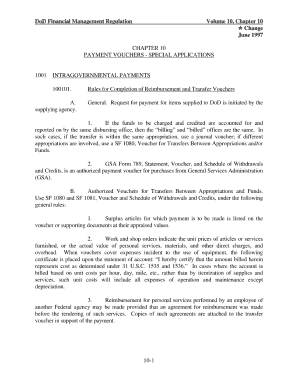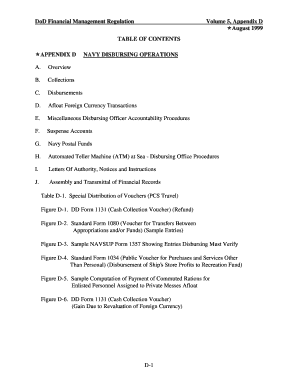Dod Financial Management Regulation
DoD Financial Management Regulation: Your Comprehensive Guide
Welcome to our ultimate guide to the Department of Defense Financial Management Regulation (DoD FMR). In this comprehensive resource, we will walk you through the important aspects of the DoD FMR and provide you with essential information to help you navigate the complex world of financial management within the Department of Defense. Whether you're a military member, a civilian employee, or simply interested in understanding more about this critical regulation, you'll find everything you need right here.
The Importance of DoD Financial Management
Effective financial management is essential for any organization, and this is particularly true for the Department of Defense. As one of the largest government departments in the United States, the DoD has a massive responsibility to ensure proper stewardship of financial resources. The DoD FMR is the guiding document that outlines the principles, policies, and procedures to achieve fiscal responsibility within the department.
Understanding DoD FMR Volume 5, Chapter 2: Treasury

One of the key chapters within the DoD FMR is Volume 5, Chapter 2, which focuses on the Treasury. This chapter provides guidance on how the DoD interfaces with the Treasury Department for financial management purposes. It covers topics such as financial reporting, budgeting, and the utilization of Treasury accounts for DoD activities.
Understanding DoD FMR Volume 6A: Financial Services

Another important volume within the DoD FMR is Volume 6A, which focuses on financial services. This volume provides detailed guidance on various financial services within the DoD, including budget execution, accounting, and disbursing activities. It is an essential resource for finance professionals and anyone involved in financial management within the Department of Defense.
3 Key Subheadings
1. Budget Process: A Step-by-Step Guide
Understanding the budget process is essential for effective financial management within the DoD. In this section, we will dive deep into the step-by-step guide on how the budget is developed, approved, and executed within the Department. From the initial formulation to the final execution, you'll gain insights into the intricacies of the DoD budget process.
2. Financial Reporting Requirements: Ensuring Transparency
Transparency and accountability are crucial in financial management. In this section, we will explore the important financial reporting requirements outlined in the DoD FMR. From the preparation of financial statements to the submission of reports, we will provide you with a comprehensive overview of the obligations and best practices for financial reporting within the DoD.
3. Internal Controls: Safeguarding DoD's Financial Resources
Maintaining strong internal controls is vital to protect the DoD's financial resources from fraud, waste, and abuse. In this section, we will discuss the key aspects of internal controls within the Department. You'll learn about the control environment, risk assessment, control activities, information and communication, and monitoring processes. Understanding these elements will empower you to contribute to a robust control framework within the DoD.
Frequently Asked Questions (FAQ)
To ensure that you have all the answers you need, we've compiled a list of frequent questions related to the DoD Financial Management Regulation. Check them out below:
Q: Who is responsible for enforcing the DoD FMR?
A: The responsibility for enforcing the DoD FMR lies with the financial management personnel within the Department of Defense. They are accountable for complying with the regulations and ensuring that proper financial management practices are followed.
Q: Can the DoD FMR be accessed by the general public?
A: Yes, the DoD FMR is a publicly available document. It can be accessed online through the Department of Defense's official website or various other platforms that provide access to government regulations and policies.
Q: Are there any penalties for non-compliance with the DoD FMR?
A: Yes, non-compliance with the DoD FMR can lead to various penalties, depending on the severity of the violation. These penalties can range from monetary fines and withholding of funds to disciplinary actions, including termination of employment or criminal charges in cases of fraud or embezzlement.
Q: How often is the DoD FMR updated?
A: The DoD FMR is subject to periodic updates to reflect changes in policies, procedures, or regulations. These updates ensure that the regulation remains relevant and aligned with the ever-evolving financial landscape within the Department of Defense.
Conclusion
The DoD Financial Management Regulation is a crucial tool that helps ensure fiscal responsibility and accountability within the Department of Defense. This comprehensive guide has provided you with an overview of the importance of the regulation, key chapters and volumes, and essential subheadings. By familiarizing yourself with the DoD FMR, you'll be equipped with the knowledge to make informed decisions and contribute to the financial management efforts within the DoD. Remember, staying compliant with the regulation is not only a requirement but also a way to safeguard the DoD's financial resources and support its mission.
DoD Financial Management Regulation Volume 6A, … / Dod-financial
 Image Source : pdf4pro.com
Image Source : pdf4pro.com DoD Financial Management Regulation Volume 9, Chapter .DoD Financial
 Image Source : pdfslide.us
Image Source : pdfslide.us dod
Volume 1, Chapter 4 DoD Financial Management Regulation / Volume-1
 Image Source : pdf4pro.com
Image Source : pdf4pro.com Fillable Online Comptroller Defense Financial Management Regulation
 Image Source : www.pdffiller.com
Image Source : www.pdffiller.com Fillable Online Comptroller Defense DoD Financial Management Regulation
 Image Source : www.pdffiller.com
Image Source : www.pdffiller.com DoD Financial Management Regulation Volume 2A, Chapter 1 DoD
 Image Source : fdocuments.in
Image Source : fdocuments.in dod
Fillable Online Comptroller Defense DoD Financial Management Regulation
 Image Source : www.pdffiller.com
Image Source : www.pdffiller.com DoD Financial Management Regulation Volume 5, Chapter 2 أ‹ Treasury
 Image Source : vdocuments.mx
Image Source : vdocuments.mx Dod financial management regulation volume 5, chapter 2 أ‹ treasury. Dod financial management regulation volume 9, chapter .dod financial. Fillable online comptroller defense dod financial management regulation. Volume 1, chapter 4 dod financial management regulation / volume-1. Fillable online comptroller defense dod financial management regulation